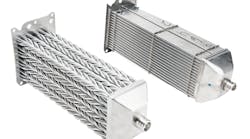We hear things like “Oh man, not again,” or “I wish we could just do away with it altogether” all the time when fleet maintenance professionals encounter ruptured EGR coolers. It seems a pretty safe bet that the subject of EGR coolers and their replacement is not a happy one when it comes to the folks who have to directly deal with the problem.
It’s an all-too-common situation: a failed EGR cooler within a diesel truck leads to replacement part costs – and, even worse -- downtime for the truck. After replacing the EGR cooler with a new OE unit, everything seems to be fine only to find the replacement EGR cooler fails. At this point, sheer frustration from the “repair” can take its toll. This can lead to fleets shedding vehicles that regularly blow through EGR coolers, and often this occurs before the expected service life of said vehicle. At this point, between part costs, labor costs, vehicle downtime and the unscheduled replacement of that vehicle, the initial procurement of the vehicle might look like a misstep.
EGR cooler failure usually results from one of three causes. The most common cause stems from thermal events. Thermal events refer to any situations where the EGR cooler, for whatever reason, isn’t getting enough coolant to prevent heat expansion inside the unit, and the metal internal core pushes the ends of the cooler apart, rupturing it. Less-common failures result from EGR coolers plugging up due to carbon deposits from exhaust, or from simple metal fatigue after several years of use.
To address these failures, there have been several advances made in EGR cooler technology in recent years. Many of these technologies are coming from the aftermarket. There’s a reason for this, and it’s somewhat unexpected: OE manufacturers generally haven’t offered solutions for EGR cooler problems after a warranty expires.
In other words, the vehicle manufacturers generally haven’t looked backwards to engineer solutions for old parts. In many cases, they’ve simply used the same historical part design as a stopgap replacement until the part or vehicle warranty expires.
This leaves fleet personnel high and dry; it’s not legal in any state to operate a diesel vehicle with a malfunctioning EGR system, but solutions for some particularly troublesome EGR coolers haven’t been available.
A notable example
In one well-known example, Ford had an issue with EGR cooler failure problems occurring in 2003-2007 Super Duty and E-Series van diesel engines sourced from Navistar International. The issue stemmed from a design flaw in the engine oil cooler, which would lead to thermal event situations, sometimes causing EGR cooler failure. A class-action lawsuit resulted, and Ford ultimately chose to build its own diesel engine for light trucks in 2010.
This was quite a significant turn of events, traceable in part to the shortcomings of the EGR cooler, a part designed to do nothing more than reroute exhaust gases back to the engine’s cylinders.
Private owners of these trucks were faced with an entire generation of potentially faulty parts. Even when EGR coolers were replaced with new units, failures would often result, and damage to other engine components could occur.
For example, during an EGR cooler rupture, coolant leaks into the exhaust gas being routed into an engine’s combustion chamber. There, steam buildup increases the cylinder pressure to the point of compromising head gaskets. This large population of truck owners continued to look for a solution, eventually turning to the aftermarket.
In 2009, Arizona-based Bullet Proof Diesel developed replacement EGR and oil coolers for the engine platform, and these were successful in stemming the failures. Other aftermarket companies followed suit, and the market for upgraded EGR coolers was born.
Expanded options
Commercial fleets have not been immune to the consequences of unreliable EGR coolers. The conventional design of the part (finned tubes that resemble a radiator) simply cannot compensate for the core expansion that results from a thermal event. In fact, the larger EGR coolers found in medium duty and heavy duty trucks are even more susceptible to damage during thermal events, because longer cores mean more heat expansion. This expansion exerts pressure on the bulkheads of the cooler, and a rupture occurs.
To address these concerns, Bullet Proof Diesel released a line of commercial duty EGR coolers with a patented core type designed to resist expansion-related ruptures in 2017.
Known as H-Core, the exhaust tubes of these EGR coolers are arranged in a helical pattern that resembles a braid. Tube expansion can be accommodated within the EGR cooler because the tubes can broaden in a lateral direction. This means the “braids” have the ability to become larger in diameter when heated. In laboratory tests, the potential pressure to the ends of an H-Core-equipped cooler was only about one-fourth of the pressure a conventional core would exert. This means the EGR cooler isn’t likely in danger of expanding to the point of ripping itself apart during a thermal event.
Options like this now provide a viable alternative for fleets in need of commercial duty EGR coolers.
Dahlin has been a respected voice in the transportation industry for almost two decades. As publisher for a number of publications, such as Hot Rod, Diesel Power, 8-Lug, Off-Road, Truckin’, Car Craft and others, Dahlin directed the evolution from print properties to multimedia enthusiast brands. Dahlin started with Bullet Proof Diesel in 2016 as Chief Marketing Officer, heading up transitional efforts to move a significant part of the business from the enthusiast space to the commercial fleet segment. Dahlin has been hosted at several universities and holds an M.A. in Speech Communication at California State University, Long Beach.


